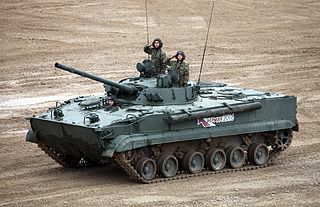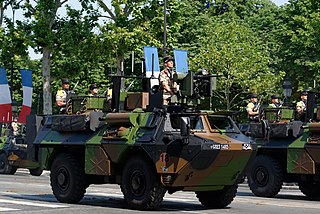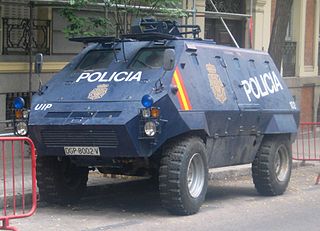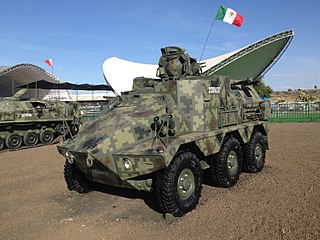
An internal security vehicle (ISV), also known as an armored security vehicle (ASV), is an armored car or armored personnel carrier used for supporting contingency operations.

An internal security vehicle (ISV), also known as an armored security vehicle (ASV), is an armored car or armored personnel carrier used for supporting contingency operations.
Internal security vehicles are typically armed with a turreted heavy machine gun and auxiliary medium machine gun. The vehicle is designed to minimize firepower dead space and the vehicle's weapons can be depressed to a maximum of 12°. Less-lethal water cannons and tear gas cannons can provide suppressive fire in lieu of unnecessary deadly fire. [1]
The vehicle must be protected against weapons typical of riots. Protection from incendiary devices is achieved through coverage of the air intake and exhaust ports as well as a strong locking mechanism on the fuel opening. Turret and door locks prevent access to the interior of the vehicle by rioters. Vision blocks, ballistic glass and window shutters and outside surveillance cameras allow protected observation from within the vehicle.
Wheeled 4×4 and 6×6 configurations are typical of security vehicles. Tracked security vehicles are often cumbersome and leave negative political connotations for being perceived as an imperial invading force.

An armoured fighting vehicle or armored fighting vehicle (AFV) is an armed combat vehicle protected by armour, generally combining operational mobility with offensive and defensive capabilities. AFVs can be wheeled or tracked. Examples of AFVs are tanks, armoured cars, assault guns, self-propelled artilleries, infantry fighting vehicles (IFV), and armoured personnel carriers (APC).

A military armoredcar is a wheeled armored fighting vehicle, historically employed for reconnaissance, internal security, armed escort, and other subordinate battlefield tasks. With the gradual decline of mounted cavalry, armored cars were developed for carrying out duties formerly assigned to light cavalry. Following the invention of the tank, the armored car remained popular due to its faster speed, comparatively simple maintenance and low production cost. It also found favor with several colonial armies as a cheaper weapon for use in underdeveloped regions. During World War II, most armored cars were engineered for reconnaissance and passive observation, while others were devoted to communications tasks. Some equipped with heavier armament could even substitute for tracked combat vehicles in favorable conditions—such as pursuit or flanking maneuvers during the North African campaign.

An infantry fighting vehicle (IFV), also known as a mechanized infantry combat vehicle (MICV), is a type of armoured fighting vehicle used to carry infantry into battle and provide direct-fire support. The 1990 Treaty on Conventional Armed Forces in Europe defines an infantry fighting vehicle as "an armoured combat vehicle which is designed and equipped primarily to transport a combat infantry squad, and which is armed with an integral or organic cannon of at least 20 millimeters calibre and sometimes an antitank missile launcher". IFVs often serve both as the principal weapons system and as the mode of transport for a mechanized infantry unit.

The BMP-3 is a Soviet and Russian infantry fighting vehicle, successor to the BMP-1 and BMP-2. The abbreviation BMP stands for Boevaya Mashina Pekhoty.

The Schwerer Panzerspähwagen, is a series of six- and eight-wheeled armoured cars that were used by Germany during the Second World War.

The Véhicule de l'Avant Blindé or VAB is a French armoured personnel carrier and support vehicle designed and manufactured by Renault Trucks Defense. It entered French service in 1979 and around 5,000 were produced for the French Army as well as for export. It has seen combat in various conflicts in Africa, Asia as well as Europe and has also been exported to more than 15 countries.

The Cadillac Gage Commando, frequently denoted as the M706 in U.S. military service, is an American armored car designed to be amphibious. It was engineered by Cadillac Gage specifically for the United States Military Police Corps during the Vietnam War as an armed convoy escort vehicle. The Commando was one of the first vehicles to combine the traditionally separate roles of an armored personnel carrier and a conventional armored car, much like the Soviet BTR-40. Its notable height, amphibious capability, and waterproofed engine allowed American crews to fight effectively in the jungles of Vietnam by observing their opponents over thick vegetation and fording the country's deep rivers.

The M1117 Guardian, also denoted Armored Security Vehicle (ASV), is an internal security vehicle based on the V-100 and V-150 Commando series of armored cars. It was developed in the late 1990s for service with the United States' Military Police Corps. The first prototypes appeared in February 1997 and serial production of the M1117 commenced between 1999 and early 2000.

The AIFV is a US tracked light armored vehicle that serves as an infantry fighting vehicle (IFV) in the armies of several countries. It is a development of the M113A1 armored personnel carrier.

The Simba is a wheeled armoured personnel carrier designed by GKN Sankey. and is currently in service with the Philippine Army.

The Dragoon 300 AFV was produced by Arrowpointe Corporation during the 1980s. It was based on the automotive components of the United States Army's M113 APCs and 5-ton trucks. It resembles a larger V-150 Commando.

The BOV, is an all-wheel drive armoured vehicle manufactured in the former Yugoslavia and today in Serbia. The second generation BOV is currently in development.

The Thyssen Henschel UR-416 is a German armoured personnel carrier, first introduced in 1969 and based on the body of the Mercedes-Benz Unimog light truck.

The D-442 FUG and D-944 PSZH are the results of Hungarian domestic development of relatively cheap amphibious armoured scout car and armored personnel carrier series. FUG and PSZH were exported with limited success, thus it is also known under its Czechoslovak designation OT-65.

An armoured personnel carrier (APC) is a broad type of armoured military vehicle designed to transport personnel and equipment in combat zones. Since World War I, APCs have become a very common piece of military equipment around the world.

The Fahd is a 4x4 Egyptian armored personnel carrier, designed to fit the requirements of the Egyptian Military. It replaced older APCs in Egyptian service such as the BTR-40, and the Walid. It has been used by the United Nations.

The Lazar BVT is a Serbian mine resistant ambush protected vehicle (MRAP), manufactured by Yugoimport SDPR and named after Prince Lazar Hrebeljanović. It is not in operational use by the Serbian Army, which uses modified version, Lazar 3.

The Panhard VCR is a light armored personnel carrier (APC) designed by Panhard for the export market and later used by several countries. After Iraq ordered French turrets in September 1974 capable of launching antitank guided missiles (ATGM), the Panhard VCR was developed at the request of the Iraqis for vehicles with which to mate these ATGM-launcher turrets. This resulted in the largest order of VCRs, 100, for Iraq.

The Oerlikon KBA is a 25 mm (25×137mm) autocannon, developed as a close range multipurpose weapon for the mechanised battlefield, originally made by Oerlikon and currently produced in Rheinmetall Italia S.p.A. facilities. It is a positively locked breech, gas and recoil operated cannon with a rotating bolt head and a dual-belt selective feed system taking a 25mm NATO cartridge. The rate of fire in burst mode is 600 rounds per minute but it can be adjusted electronically and reduced to single shot or a selectable range from 100 up to 200 rounds per minute.